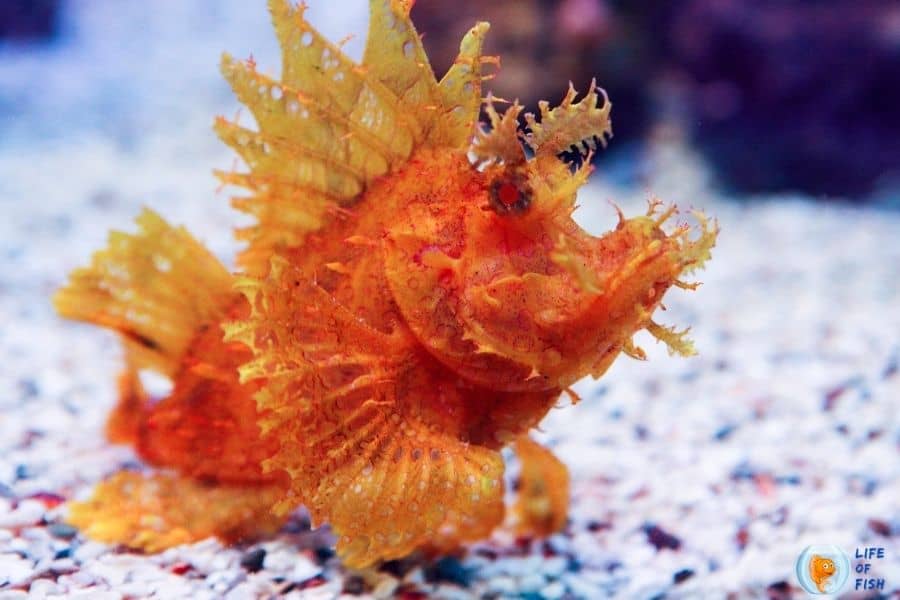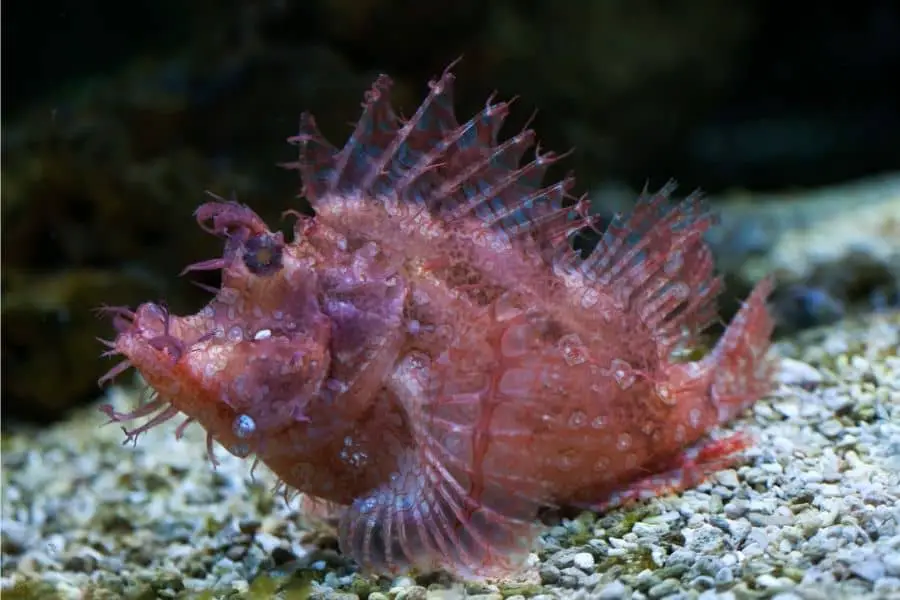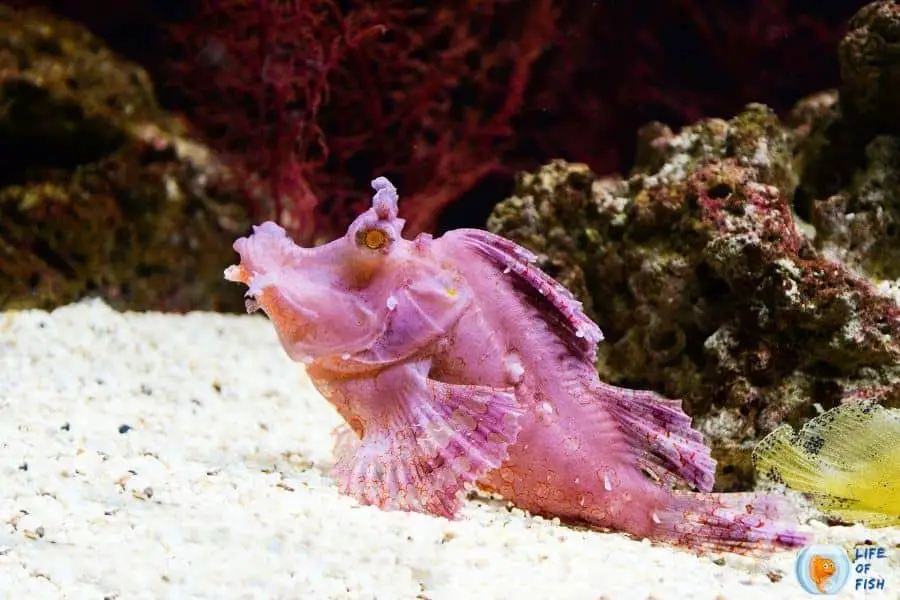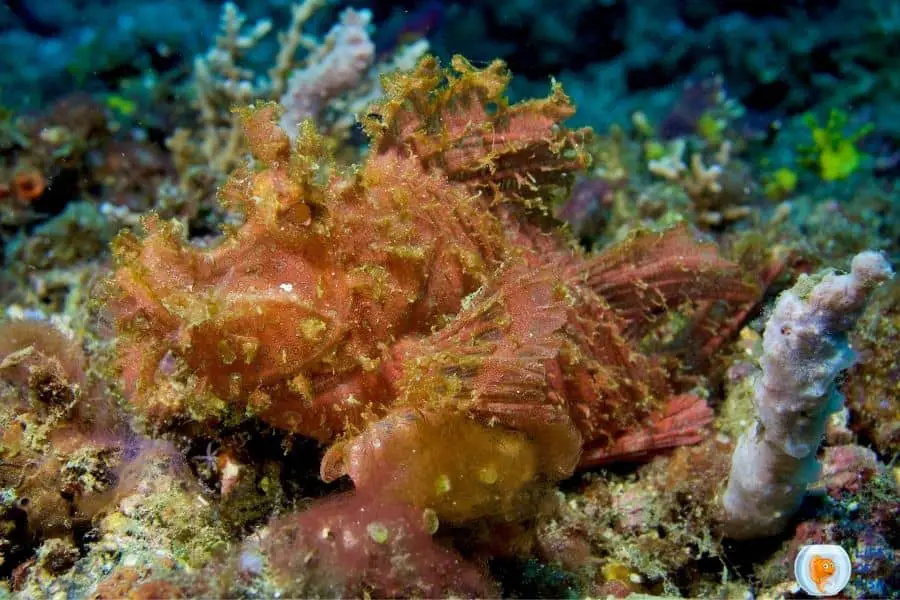Rhinopias frondosa, often known as the weedy scorpionfish or weed fish, is a ray-finned marine fish species that comes under the Scorpaenidae family.
This species was described in 1892 by Albert Günther, a German-born British biologist.
The particular term frondosa means “branched or full of leaves,” referring to the fish’s fleshy tentacles covering much of its body.
This scorpian fish species have been encountered in pairs with Rhinopias eschmeyeri, leading to speculation that they represent the two sexes of a sexually dimorphic single species.
The particular term frondosa means “branched or full of leaves,” referring to the fish’s fleshy tentacles covering much of its body.

Rhinopias frondosa Appearance
Jump To
- 1 Rhinopias frondosa Appearance
- 2 Where do they form?
- 3 Are Rhinopias frondosa aggressive?
- 4 Rhinopias frondosa’s venom
- 5 Rhinopias frondosa behavior
- 6 How long do Rhinopias frondosa live?
- 7 One look Care guide
- 8 Rhinopias frondosa care
- 9 Rhinopias frondosa breeding
- 10 Feeding behavior of Rhinopias frondosa
- 11 Rhinopias frondosa tank mates?
They have a laterally compressed body and are covered with weed-like filaments and as far as color, they can be red, white, yellow, or purple.
You can find two little black dots with a smaller diameter on the soft-rayed region of the dorsal fin.
Their rising eyes are on the top of their heads, and dermal tentacles are above their eyes, on the jaws, and on the body surface. The supraocular and posterior lacrimal spines have fleshy tentacles.
The dorsal fin contains 12 spines and 9 soft rays, while the anal fin has 3 spines and 5 soft rays.
In the caudal fin, the tip of each fin ray is split into four branches while the dorsal fin’s spines are relatively flexible, with tips that bend easily under pressure.
The soft-rayed sections of the dorsal, pelvic, anal, and caudal fins have either no notches or very mild notches on their distal borders.
Where do they form?
They reside in the Indian Ocean and Western Pacific Ocean, particularly from Japan to Australia, and from South Africa to the Caroline Islands.
They prefer the depth range of 13 to 90 meters. In the sea, they can be easily observed in rocky or coralline habitats among algae-covered substrates due to their camouflage behavior.
Thus, they mimic filaments of seaweed waving in the currents. Further, they prefer to dwell in rich soft-bottom environments to ease their crawling movements and in channels with a substantial current system to move naturally well with the current’s rhythmic wavering.
Are Rhinopias frondosa aggressive?
Scorpionfish have venomous spines, and their stings are able to bring a lethal effect on humans. Fortunately, these fish are not aggressive and will only sting if they perceive a threat.
Rhinopias frondosa’s venom
Scorpionfish are all venomous. The stonefish, which is the most poisonous fish in the world, belongs to the Scorphiadae family.
Although R. frondosa doesn’t have as strong a venom as stonefish since they belong to different subfamilies. It is needed to handle and move these fish with extreme caution.
Rhinopias’ hypodermic spines are in their dorsal, anal, and pelvic fins. And they are lined about a third of the way up with venom-producing glands that release at stress.
Their venom induces a burning feeling at the puncture site that ranging from mild to severe. This discomfort might extend from a few hours to several days.
Nausea and vomiting, headaches, hypotension, chest discomfort, irregular pulse, and potential loss of consciousness are some of the systemic symptoms.
The proteins that form scorpionfish venom are heat-sensitive, which means they deactivate when exposed to heat.
When treating a sting, soak the wounded region in hot water for as long as you can stand it for 30-90 minutes, or until it is no longer painful to remove it from the water.
Most importantly, their venom can remain as active in the fish body for up to 48 hours after they die.

Rhinopias frondosa behavior
Weedy scorpionfish, like the rest of the species of scorpaenids, are nighttime (nocturnal) predators who use their camouflage for hunting unwary small invertebrates and fish while hiding in corals, rocks, and seaweeds.
The scorpaenids’ mouth is massive, permitting it to efficiently grasp and swallow complete prey in one gulp.
As a sluggish fish species, they barely swim but instead move like crawling along the bottom using their pectoral and pelvic fins while their camouflage mechanism assists them to be safe from their natural predators as well.
However the cuticle, or outer epidermal layer, of Rhinopias sp. is routinely shed. This Shedding assists in the removal of algae, parasites, and shedding species from the body, and it can be fairly frequently as every 12 days.
If the fish is having parasite problems, the rate of shedding may increase. You should not surprised if Rhinopias’ eyes appear clouded already when they shed as it happens sometimes.
Furthermore, to facilitate the shedding process, scorpionfish may place themselves next to a powerful flow of water.
How long do Rhinopias frondosa live?
The majority of scorpionfish species are under two feet long and have a 15-year lifetime.
One look Care guide
| Scientific name | Rhinopias frondosa |
| Common name | Weedy scorpionfish or weed fish |
| Care level | High |
| Native to | Indo-West Pacific region |
| Type | Reef fish |
| Color | Camouflage (red, white, yellow, or purple) |
| Tank size | 20 to 30 Gallons |
| Prefered temperature | 23 to 27 0C |
| Other water parameters | pH of 8.1 to 8.4Ammonia – at a lowest possible |
| Prefered salinity | 35 ppt |
| Growth rate | Very slow (reach the maximum 22cm within 5 year period) |
| Temperament | Sedentary, nocturnal ambush predator |
| Recommended tank mates | Puffers Triggers Groupers Anglers Tusk fish large wrasse other scorpionfish |
| Prefered food | Small crustaceans Mollusks Damsel like small fish |
| Feeding frequency | 2 or 3 times per week |
| Breeding | Wild breeding only Captive breeding has not been identified yet. |
Rhinopias frondosa care
Rhinopias frondosa size
These scorpaenids typically grow up to 9 inches in length at their maximum total length.
Rhinopias frondosa tank size
Rhinopias sp. adapts well to captivity and they can keep in smaller aquariums since they are solitary. A smaller-sized Rhinopias sp. You should keep Individuals in a tank of at least 20 gallons, while you can keep larger adults in a regular 30-gallon tank.
How many Rhinopias frondosa to keep together?
Since they are highly valued predatory fish it is better if one specimen keep in a single aquarium. Or you can keep the same age and sized pair in an aquarium relative to the tank spaces and the tank setup.
Tank setup
FOWLR Aquarium
Aquariums with only live rock and fish would be more successful for Weed fish.
When pairing them with butterflyfish, tangs, angelfish, or parrotfish, take caution because the Rhinopias can camouflage as a rock coated in encrusting crustaceans or algae by these fish.
Furthermore, grazing fish naturally draw toward Rhinopias due to the algae forms on the bodies of Rhinopias.
This attraction has the potential to result in unfavorable outcomes as If the Rhinopias might be harmed and infected, or the grazing fish might be harmed by the stinging spines of the Rhinopias.
Because of their vivid color, these grazing fish usually avoid Rhinopias, but aquarists must be cautious.
In a FOWLR tank, large wrasse, hogfish, rabbitfish, and other substantially sized fish will harmoniously cohabit with Rhinopias.
Reef Aquarium
Rhinopias can live in a few types of reef aquariums, but not in a conventional reef system.
Generally, they do not disturb any coral types or coral polyps. You should not keep Rhinopias with any small ornamental fish or crustaceans. Since they are prone to take them as their diet.
Therefore, an understanding of the predatory ability of weed fish is a must before setting up the tank.
And also, it is not recommended to keep them in SPS systems with high flow and light. They can not manage the constant high flow of the surroundings since they’re very poor swimmers.
You should maintain open regions in the sand for them to perch when keeping them in mixed reefs with sand-dwelling LPS.

Water quality condition
As a marine fish, the Weed Scorpionfish prefers 35 ppt saline water under temperatures of 23 to 27 Celcius degrees with a pH of 8.1 to 8.4.
It is better to have a regular water change schedule. Because scorpionfish eat a lot, waste levels in the aquarium will be high, necessitating frequent water changes.
Rhinopias can not tolerate poor water quality, and keeping nitrogen compounds and metabolites at the lowest possible levels is essential.
Unstable water conditions will eventually harm the fish, generating stress and becoming more aggressive.
An efficient filtration system, a heater, and frequent tank care, including weekly water changes, are all required for the fish. Keeping the water clean is beneficial not just to the scorpionfish, but also to any tankmates.
Rhinopias frondosa breeding
Rhinopias frondosa male or female identification
There is no clear guide to differentiating Rhinopias frondosa species’ male or female yet. In the field, it is nearly impossible.
But sometimes Rhinopias eschmeyeri and Rhinopias frondosa identified as male and female Rhinopias frondosa.
However, some fish experts say that Rhinopias eschmeyeri and Rhinopias frondosa is a single species. This is due to both varieties frequently observed together and they just show the sexual dimorphism characteristics.
It might be useful to distinguish the difference between Rhinopias eschmeyeri and Rhinopias frondosa.
The membrane between the spines and rays of the first and second dorsal fins is one main feature that distinguishes these two.
The first dorsal fin of the Eschmeyer’s scorpionfish is virtually sail-like in some individuals. The membrane of the weedy scorpionfish is severely cut, giving the dorsal edge a jagged appearance.
R. eschmeyeri has a consistent body color, but R. frondosa has circular and oblong pale patches and blotches (which can be less noticeable in some individuals).
Their tentacles are located above the eyes (supraorbital tentacles) of R. eschmeyeri and are unbranched and flattened (leaf-like), whereas those of R. frondosa are branching.
Hence, the fish experts believe these morphological differences might be due to sexual dimorphism in the same species.
Identify pregnant Rhinopias frondosa
There is no record to identify pregnancy stage-related characteristics of the Rhinopias frondosa.
How to breed Rhinopias frondosa
Due to its mysterious breeding behaviour captive breeding of Rhinopias frondosa is difficult.
Reportedly, they like to be in pairs during the mating season like the other species of Scorpaenids in the wild.
How many babies does Rhinopias frondosa have?
A female scorpionfish can deliver up to 15,000 eggs into the water for male scorpionfish to fertilize.
Rhinopias frondosa fry care
The fertilized eggs reach the surface, where they are less likely to be eaten by egg-eating predatory animals.
The eggs will hatch in two days, and the juvenile scorpionfish will stay closer to the surface until they become mature enough to dive down to the reefs where their matured fish dwell.
It is a must to keep these fingerlings away from the other predatory fish.

Feeding behavior of Rhinopias frondosa
What do they eat?
In the wild these inactive predators feed on small crustaceans, mollusks, and fish.
However, feeding a scorpionfish, especially a Rhinopias, is generally the most difficult aspect of keeping them in an aquarium. Unfortunately, many individuals do not eat anything except live food sources.
There are several factors to consider while providing live food to captive R. frondosa. Freshwater livebearers, such as feeder guppies and mollies, are the best and most practical live feeds for Rhinopias.
Live food
The Rhinopias consumes any live food you feed it. Keepers who fatten the live food before giving it to the predatory fish benefit the scorpionfish.
Guppy: Feed frozen PE Calanus soaked with silicon to guppies. Feeder fish should be fed for a week and given a decent quantity of meals before being fed to Rhinopias scorpionfish.
Gold fish: In practice, avoid feeding goldfish entirely. The enzyme thiaminase is found in Raw goldfish. When this happens in large amounts, thiamin (Vitamin B1) becomes inactive.
A regular diet of goldfish will deplete the Rhinopias’ thiamin levels, resulting in fatigue at feedings.
Some of the more picky individuals will only eat Damsels or Chromis at first since they are accustomed to them.
Before an aquarist starts giving frozen items to a Rhinopias, make sure it has a strong appetite and consumes live food enthusiastically.
Then, from the live feeder tank, feed dead prays (dead guppies or damsels). Rhinopias may be more responsive to frozen meals after reacting to dead feed items.
It appears that the frozen meals that most closely resemble the Rhinopias’ natural prey should be prioritized.
Rhinopias will eat frozen meals such as jumbo mysis, chopped shrimp, silverside, clam, and squid. Every aquarist with a Rhinopias, should strive to feed it frozen meals. Long-term feeding of live meals is not as practical as feeding frozen items.
When interacting with or hand-feeding any scorpionfish, gloves, tongs, portable barriers, and great vigilance are your greatest allies.
How often should you feed
These ambush predators need not require daily feeding. Therefore, Rhinopias should be fed two to three times each week until their paunch region attains a small bulge.
When should you feed
Rhinopias are usually nocturnal predators, but they consume everything they can. They will strike once the food is available or within the touch. It is easier to overfeed them because of their innate enthusiasm for eating.
How long they can go without food
Rhinopias frondosa can starve for up to 3 to 4 days after being properly fed.
Rhinopias frondosa tank mates?
If someone wants to keep Rhinopias with other tankmates, needed to be concerned about three things to make the tank atmosphere more harmonic.
R. frondosa is venomous
Rhinopias that are naturally attracted to grazing fish owing to the algae that grow on their bodies.
This attraction might have negative consequences, as the Rhinopias could be injured and infected, or the grazing fish could be hurt by the Rhinopias’ stinging spines.
R. frondosa is carnivorous
Rhinopias should not be kept alongside small ornamental fish or crustaceans since they are likely to eat them.
Even if a tankmate is too huge to fit in the Rhino’s mouth does not mean it won’t be eaten. Rhinopias may expand their jaws to enormous proportions and they can ingest prey nearly as large as itself.
Avoiding Competition
Keep Rhinopias away from any other predatory fish that could compete for their food with them.
For an instance, the Rhinopias are ambush predators who like to stay and wait for a meal rather than chasing it down like groupers.
Therefore, when maintaining a rhino alongside another predator, the keeper must feed the quicker predator until it is satisfied, then concentrate on the Rhinopias.
Of course, this takes considerably longer, and the other fish is overfed.
In a FOWLR tank, large wrasse, hogfish, rabbitfish, and other substantially sized fish will harmoniously cohabit with R. frondosa.
Rhinopias should not be kept in larger predator aquariums since they are cryptic by the origin, and other large predators will dominate or even feed on smaller species.
Huge eels, large groupers, sharks, large triggerfish, and rays should not be housed with Rhinopias.
Though, Rhinopias frequently get along with smaller predatory fish like puffers, triggers, groupers, anglers, tusk fish, large wrasse, and other scorpionfish.
Read Next : Yellow Stripe Clingfish Care | A Needle Like Fish |

